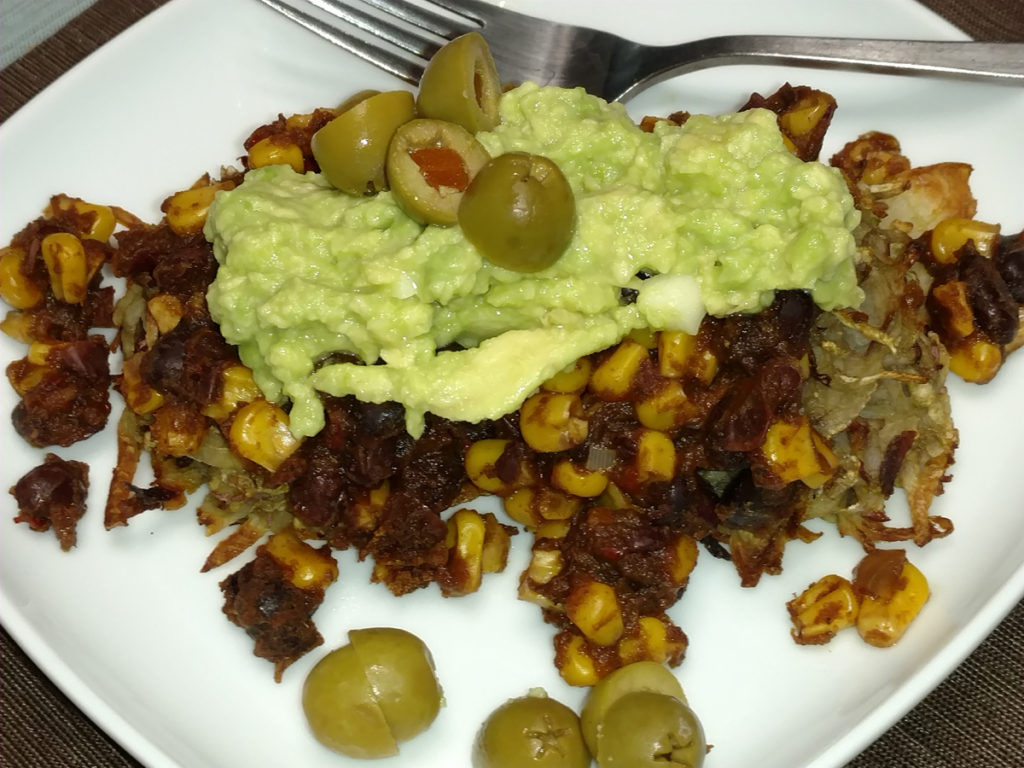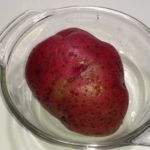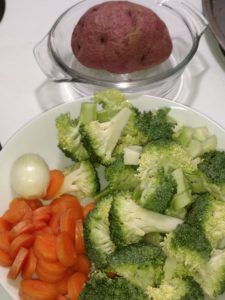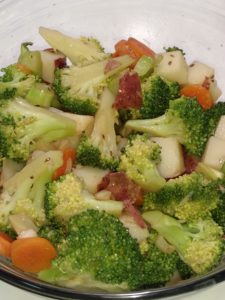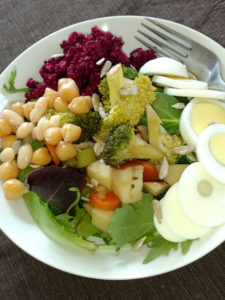Latke Tacos
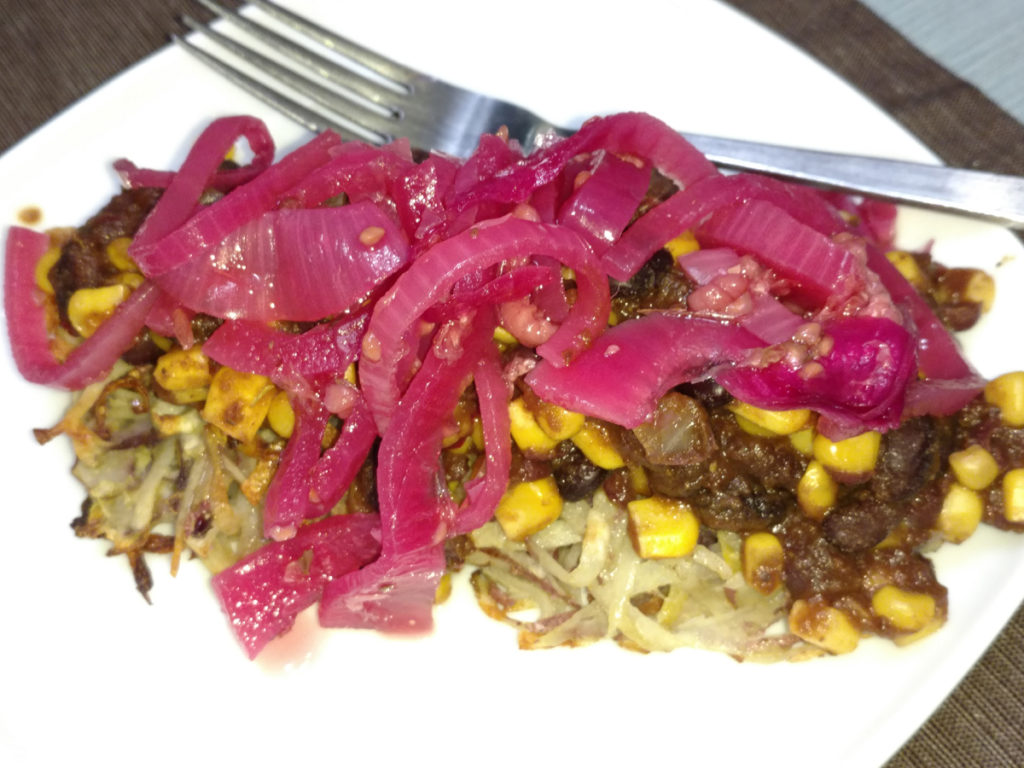
One day last week, I got the idea to make Latke Tacos. I’d never made latkes before, but a friend started talking about them and… What can I say? My creative muse took over. The next day, I set out to use only items on hand to whip up a batch of Latke Tacos.
Quick summary of the back story. In addition to the functional gut work I’ve been offering for several years now, I’ve lately been studying the human gut microbiome in some depth. We’ll discuss this separately, but let’s just quickly mention that bacterial diversity in the gut is really good for your health. It’s possible to fairly easily determine where you stand with respect to good bugs / not-so-good bugs. Who is present in your gut? How do the numbers look? How does the balance look? What’s to be done to improve upon it? (We can answer these questions for you as an individual if you’re intrigued and want to optimize your health.)
Whole Plant Food Diversity
For the last several months, I’ve been playing a little game with myself (and a few friends, and a few functional nutrition clients). Our goal is to consume, on average, 40 distinct whole plant foods in any given week. No single food is off limits, though some of us do have select foods that we avoid or keep to a minimum for one reason or another.
From there, it’s not hard to develop a simple supplementation strategy to skew the balance in your favor. Food choices have a lot to do with how well this all shakes out. Specifically, eating a diversity of whole plant foods.
In addition to diversity, I’ve been considering a few other factors. Polyphenols. Resistant starches. Whenever possible, I’m creating more complex dishes, including reds, purples, and dark colored foods, and looking for opportunities to eat some of my starches at room temperature or cooler. (Think potato salad, rice pudding, leftover refried beans.)
“If we had leftover latkes,” was my thinking, “then we could make tacos on top of them! Latke tacos! And the latkes themselves would be resistant starch.” Brilliant! (My creative muse has a funny sense of humor.)
Important note!
You’ll notice that this isn’t exactly a “recipe.” It’s some thoughts on how to creatively craft a diverse plant food dish. Let your muse out and have some fun!
Step 1: Make the Latkes
My first step was “Only items on hand”. It was the day after a major holiday and snowing. Grocery shopping was not high on my agenda. But I do keep a fairly well-stocked pantry. Here’s what went into the latkes (yield = 15 latkes):
- Two good-sized red potatoes, shredded with food processor
- A couple of onions from last summer’s garden, minced
- Diversity add-ins (Let your mind go wild — I had a chunk of daikon and a red carrot in the fridge, so I shredded them with the potatoes. Other ideas are beet, sweet potato, turnip, kohlrabi, or something else of a similar texture. The more the merrier!)
- Two eggs. For an egg-free or vegan version, I think “flax eggs” would work. If you try this, please leave a comment and let me know.
- Two Tablespoons of “flour”. I used chick pea flour. Any type of flour or thickener should do the trick.
- Salt to taste (optional)
Putting the latkes together:
You’ll want to get some of the moisture out of the veggie mixture. Put the potato / onion / add ins into a square of cheesecloth and hung it over a bowl for ten minutes or so. Then squeeze out as much moisture as you can, discard that, and place the squished veggies into a mixing bowl. Mix in the eggs, flour, and salt.
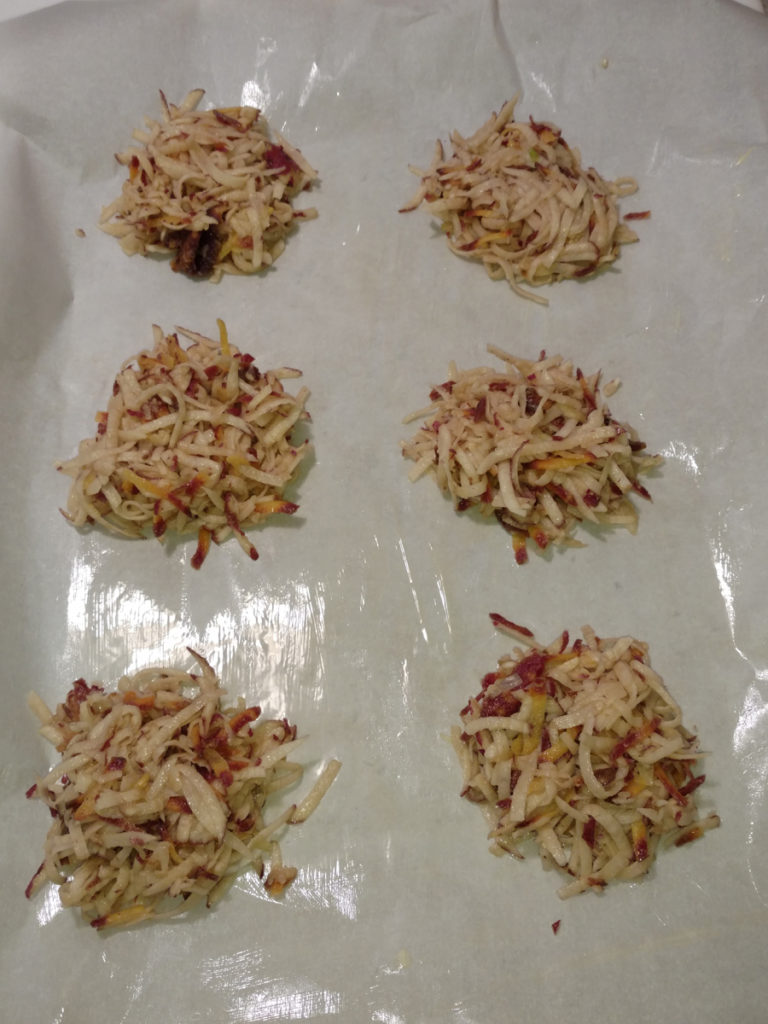
Preheat your oven to 400 degrees F. If using parchment, check the box to see what temperature your brand is rated for. Mine said 420 F.
Latkes are usually fried on the stovetop. I’m not a big fan of that cooking method. Plus I wanted to leave the door open for room-temperature leftovers (resistant starch) and I didn’t think a fried version would work very well in that situation. I baked them.
Spread a little butter or coconut oil on parchment paper with just-washed fingers. (Or use a glove or spatula.) Put that on a baking sheet. Then scoop out 1/3 cup of the mixture and flattened slightly. See the pieces of red carrot? Festive, eh? Bake 15 minutes on one side, then remove from the oven and flip them. Bake 10 minutes on the other side.
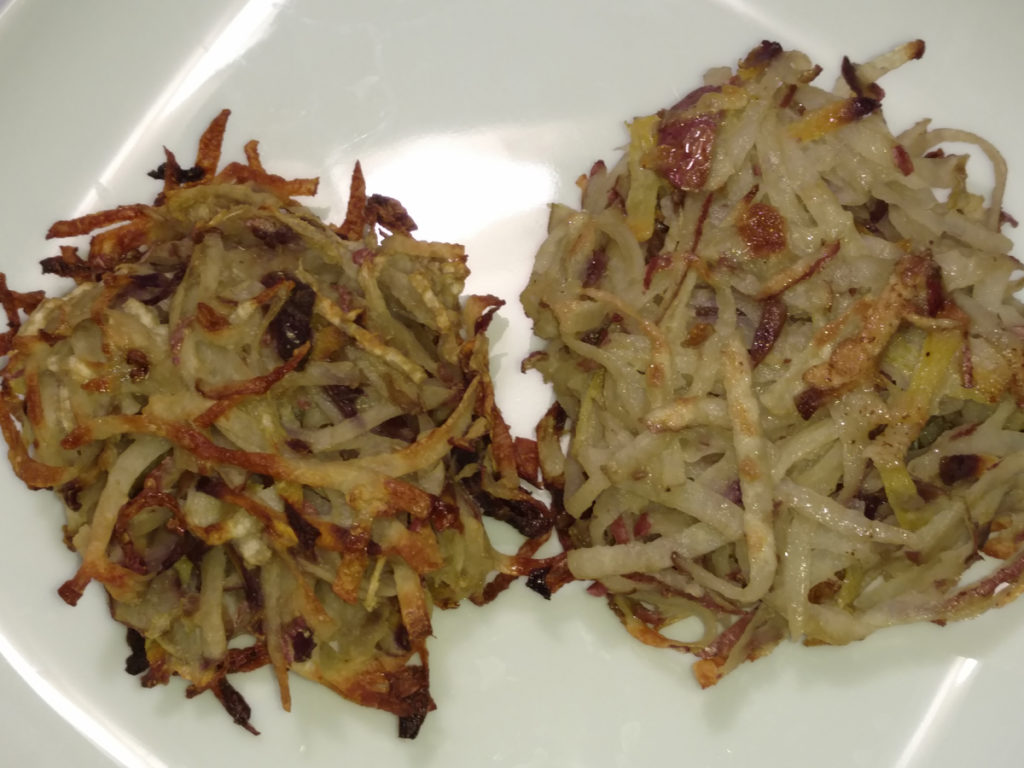
I wanted to see if the stovetop version would be better than baked. I put a little butter into a frying pan and pan-fried a few test latkes. Here is a sample of each. The baked latke is on the left, and pan-fried on the right. The pan-fried latke looks more moist. Once they were topped with the taco filling, I couldn’t tell the difference. It’s up to you how you want to cook them.
Step 2: Make the taco topping mixture
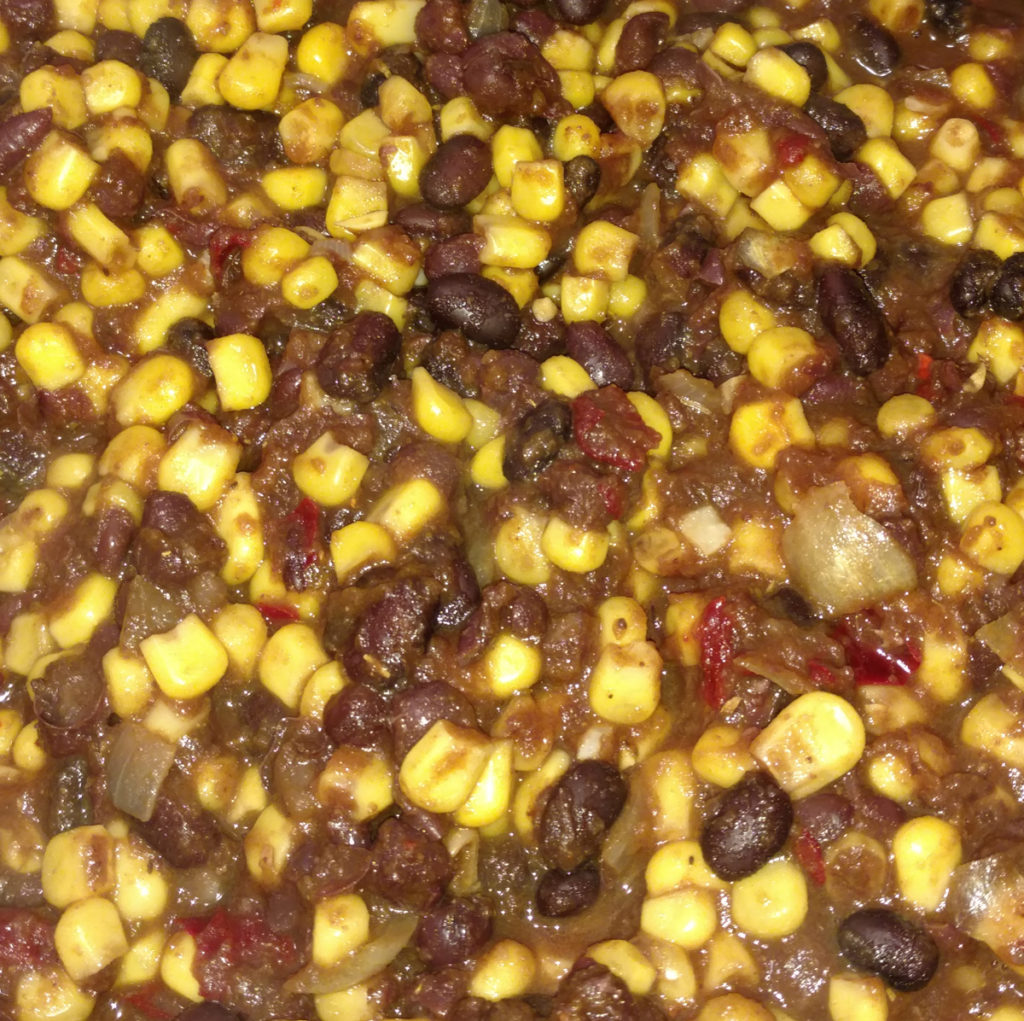
Next make the topping mixture. This will make your plain latkes into Latke Tacos! Keep in mind I was using only items on hand. Here’s what went into the mixture:
- Dried beans. I used 1/3 cup black beans and 1/3 cup red beans for diversity. Other options would be garbanzos, great northern, or navy beans. You’re aiming for about 2/3 cup of dried beans. Pre-soak, then cook (about an hour) — preferably ahead of time. If you’re in a hurry, use a can of pre-cooked beans.
- Organic canned corn — I had this in the cupboard. If your family doesn’t use corn, I would substitute chopped red (or green, or a mixture) cabbage.
- Diversity ingredients: You could add additional shredded vegetables here. Zucchini, carrots, or parsnips come to mind. Maybe beets. I’ll bet that a bit of cooked / pureed pumpkin or winter squash would be delicious, especially if you use a less saucy tomato product than I did.
- Tomato — I had home-canned tomato paste from garden tomatoes. An 8 oz jar. It’s a bit saucier than commercial paste. In the summer, I would use fresh tomatoes. Sun-dried tomatoes should be really nice! If your family doesn’t do well with nightshades, try a combination of well-cooked and pureed beets + pumpkin instead. Let me know if you try it!
- Pepper — one dried Anaheim (left from the summer garden).
- Chopped onion (left from the summer garden).
- Chopped garlic (left from the summer garden).
- Seasonings: 1/2 – 1 teaspoon each of cumin, chili powder, oregano, and salt, to your family’s taste. If you like cilantro and have some on hand, add that as well.
How to put it together:
In a medium frying pan, warm some coconut oil (or whatever you prefer to use). Saute the onion, garlic, and cabbage if using. When they’re softened, then add remaining ingredients and heat through.
Step 3: Plate and top your Latke Tacos
For each adult serving, put two of those yummy baked or pan-fried latkes on a medium plate and spoon taco topping on top. You’ll probably also want a garnish. Here are some ideas:
- Pickled red onion — I’d made this previously and had it on hand in the fridge. Pretty festive, eh? Will post the recipe separately.
- Guacamole and olives — Oooh, oooh. This was such a yummy variation with some of the leftovers. Yep, I had a ripe avocado on hand. Mashed it up with a little lemon juice, a clove of minced garlic, and some salt. Yum.
- Avocado chunks — in case you don’t want to make it into guacamole, just cut an avocado into chunks.
- Tomato chunks — in season, I might cut up some cherry tomatoes as a topper
- Sour cream / cheese — for those who enjoy dairy, this might be just the thing. Let me know if you try it!
- Let your creative muse inspire you. Leave a comment below & share your ideas!
So there you have it! Latke Tacos! This batch yielded 4 hearty servings + extra latkes. Serve with a side salad or slaw if you like.
Plant Food Diversity Update
In my original version, my count came to 12 plant foods. (I’ll share here that there is a secret ingredient in the pickled red onions — garden raspberries from the freezer. Oh yum.) Substituting guacamole and olives on the leftovers round added two more plant foods to the week’s tally.
If you’d like to get in on the Whole Plant Food Diversity experience, follow the WellnessImages Facebook page for updates. Also, if you’d like to learn more about what’s in your own gut, along with individualized strategies to balance things out in your favor, consider one of the functional nutrition testing / consultation options you’ll find on the Wellness Images website.
Happy feasting!
